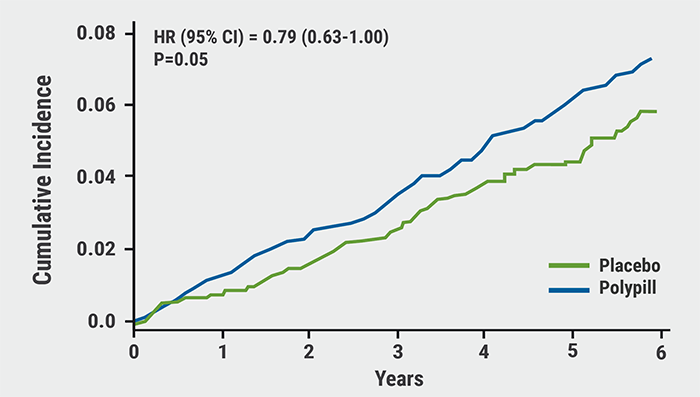Prof. Gerasimos Filippatos (National and Kapodistrian University of Athens, Greece) shared the results of the phase 3 FIDELIO-DKD trial (NCT02540993), which was designed to evaluate the efficacy of finerenone in slowing CKD progression and reducing CV events in patients diagnosed with advanced CKD and type 2 diabetes; these results were simultaneously published in the New England Journal of Medicine [1,2]. Finerenone is a non-steroidal, selective mineralocorticoid receptor antagonist which reduces the urinary albumin-to-creatinine ratio in patients with.
FIDELIO-DKD randomised 5,734 participants across 48 countries to receive either a once-daily dose of 10 mg or 20 mg oral finerenone or placebo. During a run-in period of 4–16 weeks, CV and diabetes therapy was optimised; RAS inhibitors were titrated to a maximum dose. Adults with type 2 diabetes and CKD who were treated with a RAS inhibitor at the maximum dose on the manufacturer’s label were eligible. Median follow-up was 2.6 years. The primary endpoint was a kidney composite endpoint of time to kidney failure, sustained ≥40% decrease of estimated glomerular filtration rate (eGFR) decrease from baseline, or death from renal causes.
The primary endpoint occurred in 504 (17.8%) and 600 (21.1%) participants in the finerenone and control group, respectively (HR 0.82; 95% CI 0.73–0.93; P=0.0014). The number of participants requiring finerenone treatment to prevent one primary outcome was 29. The key secondary endpoint was a CV composite endpoint of time to CV death, non-fatal MI, non-fatal stroke, or hospitalisation for HF. This endpoint was reached by 367 (13.0%) versus 420 (14.8%) participants in the finerenone and placebo groups, respectively (HR 0.86; 95% CI 0.75–0.99; P=0.03). In the finerenone group, there was a relative risk reduction of 20% for non-fatal MI (HR 0.80; 95% CI 0.58–1.09), while the incidence of non-fatal stroke was similar (HR 1.03; 95% CI 0.76–1.38). Prof. Filippatos added that the CV benefit on finerenone was consistent across subgroups with CV disease (including atherosclerotic CV disease and HF) and without CV disease.
The incidence of treatment-emergent adverse events (AE) and serious AEs was similar between both groups. The rate of serious AEs was 31.9% in the finerenone group and 34.3% in the placebo group. Specifically, hyperkalaemia-related AEs were twice as frequent in the finerenone group (18.3% versus 9.0%); these events were manageable. There was a modest effect on blood pressure, with a mean maximum decrease of 3.2 mmHg. The safety profile was similar for patients with and without CV disease.
In conclusion, FIDELIO-DKD demonstrated that finerenone treatment lowered the risk of CKD progression and CV events in participants diagnosed with type 2 diabetes and advanced CKD.
- Filippatos G, et al. Finerenone and Cardiovascular Outcomes in Patients With Chronic Kidney Disease and Type 2 Diabetes. LBS.07, AHA Scientific Sessions 2020, 13–17 Nov.
- Bakris GL, et al. New Engl J Med 2020;383:2219-2229.
Posted on
Previous Article
« Mavacamten effective in obstructive hypertrophic cardiomyopathy Next Article
Sotatercept: potential new treatment option for PAH »
« Mavacamten effective in obstructive hypertrophic cardiomyopathy Next Article
Sotatercept: potential new treatment option for PAH »
Table of Contents: AHA 2020
Featured articles
COVID-19 and Influenza
Fewer CV complications than expected in AHA COVID-19 Registry
Worse COVID-19 outcomes in younger obese patients
Effects of CVD in hospitalised COVID-19 patients
Unfavourable outcomes for COVID-19 patients with AF and atrial flutter
High-dose influenza vaccine in patients with CVD
Atrial Fibrillation
Vitamin D or omega 3 fatty acids do not prevent AF
Active screening for AF improves clinical outcomes
AF screening in older adults at primary care visits
CVD Risk Reduction
Clever trial design gets patients back on statins: the SAMSON trial
Polypill plus aspirin reduces cardiovascular events
Lowering LDL cholesterol in older patients is beneficial
No CV benefit from omega 3 in high-risk patients
Safety and efficacy of inclisiran for hypercholesterolemia
Remote risk management programme effective and efficient
Healthy lifestyle lowers mortality irrespective of medication burden
Heart Failure
Omecamtiv mecarbil improves outcomes in HFrEF-patients
IV iron reduces HF hospitalisation
Dapagliflozin reduces renal risk independent of CV disease status
“Strongly consider an SGLT2-inhibitor in most T2DM patients”
Additional HFrEF education and patient-engagement tools
Acute Coronary Syndrome
No benefit from omega-3 fatty acids after recent MI
PIONEER III trial: Drug-eluting stents comparable
Coronary and Valve Disease
Extra imaging reveals cause of MINOCA in women
Ticagrelor not superior to clopidogrel after elective PCI
Stroke
Ticagrelor/aspirin reduces stroke risk in patients with ipsilateral cervicocranial plaque
AF monitoring following cardiovascular surgery
Miscellaneous
PAD: Rivaroxaban reduces VTE risk after revascularisation
Sotatercept: potential new treatment option for PAH
Finerenone lowers CV events in diabetic CKD patients
Mavacamten effective in obstructive hypertrophic cardiomyopathy
Children exposed to tobacco smoke have worse heart function as adults
Transgender people have unaddressed heart disease risks
Intensive blood pressure lowering benefits older adults
Longer chest compression pause worsens outcomes after paediatric IHCA
Related Articles

February 17, 2021
Polypill plus aspirin reduces cardiovascular events
February 18, 2021
Dobutamine versus milrinone in cardiogenic shock
February 17, 2021
Lowering LDL cholesterol in older patients is beneficial
© 2024 Medicom Medical Publishers. All rights reserved. Terms and Conditions | Privacy Policy
HEAD OFFICE
Laarderhoogtweg 25
1101 EB Amsterdam
The Netherlands
T: +31 85 4012 560
E: publishers@medicom-publishers.com

